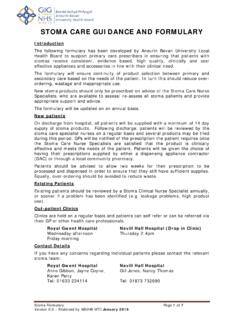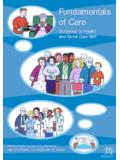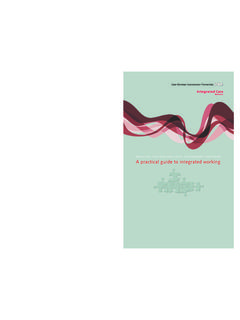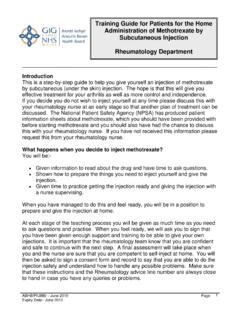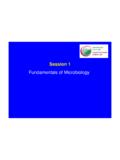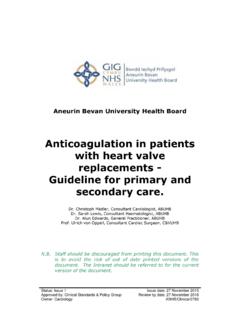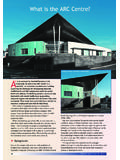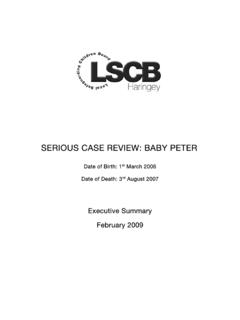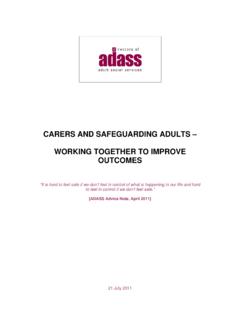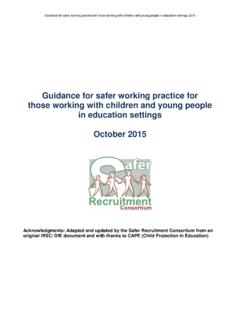Transcription of Contents
1 Contents Page Preface Guidance 1. The status and content of this guidance 3. Key definitions and concepts 5. Executive Summary 9. Chapter 1: The Legislative Framework 23. The children Act 1989. Education Act 1996. Housing Act 1996. Education Act 2002. The Licensing Act 2003. Housing Act 2004. The children Act 2004. Other legislation Chapter 2: Roles and Responsibilities - Section 28 of the 35. children Act 2004. Duty to safeguard and promote welfare Framework for making effective arrangements to safeguard and promote children 's welfare Strategic and organisational arrangements Monitoring and inspection of safeguarding and promoting welfare arrangements Arrangements to safeguard and promote children 's welfare in various agencies Local Authorities The National Health Service The Police British Transport Police The National Probation Service Youth Offending Teams Prisons/Juvenile Secure Estate Secure Training Centres Chapter 3: Roles and Responsibilities of the Welsh 99.
2 Assembly Government and Others The children And Family Court Advisory And Support Service (CAFCASS). The Care Standards Inspectorate for Wales (CSIW). The children 's Commissioner for Wales The armed services The voluntary and private sectors Faith communities The wider community Chapter 4: Local safeguarding children Boards 113. Membership Other board members Involvement of other agencies and groups CAFCASS Cymru Care Standards Inspectorate Wales (CSIW). Others Functions of safeguarding boards Scope of interest Organisation and governance LSCB boundaries Planning Monitoring and inspection LSCB protocols Regional Child Protection Forums The All-Wales Child Protection Procedures Group Chapter 5: Planning and safeguarding Structures 129.
3 Local safeguarding children Boards children and young people's partnerships Community safety partnerships Core partners The role and remit of the strategic group Chapter 6: The Impact of Abuse and Neglect 137. Introduction Abuse and neglect The concept of significant harm Findings from recent inquiries and serious case reviews: implications for policy and practice Chapter 7: Principles of Working with children and their 149. Families Introduction A shared responsibility Working in partnership with children and families Diversity An integrated approach Inter-agency co-operation to improve the wellbeing of children Some implications for policy and practice Chapter 8: Handling Individual Cases 161.
4 Introduction Working with children about whom there are child welfare concerns Principles underpinning work to safeguard and promote the welfare of children Being alert to children 's welfare The welfare of unborn children The processes for safeguarding and promoting the welfare of children Referrals to local authority children 's social services where there are child welfare concerns Making a referral Information sharing Confidentiality Allegations of harm arising from underage sexual activity Social service's response to contacts and referrals Immediate action to protect a child Initial assessment Next steps child in need but no suspected actual or likely significant harm Next steps child in need and suspected actual or likely significant harm Immediate protection Strategy discussion Section 47 enquiries and core assessment Investigative interviews of children Child assessment orders The impact of section 47 enquiries on the family and child The outcome of section 47 enquiries Concerns are not substantiated Concerns are substantiated.
5 But the child is not judged to be at continuing risk of significant harm Concerns are substantiated and the child is judged to be at continuing risk of significant harm The initial child protection conference Complaints about a child protection conference Administrative arrangements and record keeping Action following the initial child protection conference The child protection plan Intervention The child protection review conference Decision making Pre-birth child protection conferences and reviews children looked after by the local authority Recording that a child is the subject of a child protection plan Managing and providing information about a child Recording Chapter 9: safeguarding children who may be Particularly 221.
6 Vulnerable Introduction children living away from home Investigating organised or multiple abuse children in hospital children in custody Abuse of disabled children Abuse by children and young people children whose behaviour indicates a lack of parental control Domestic abuse Sexual exploitation of children Child abuse images, the internet and information technology Fabricated or induced illness children of substance misusing parents Child abuse linked to belief in possession or witchcraft , or in other ways related to spiritual or religious belief children and families who go missing Looked after children who run away or go missing from their care placement children who go missing from education children of families living in temporary accommodation Migrant children Female genital mutilation Forced marriages Chapter 10: Serious Case Reviews 249.
7 Introduction The purpose of reviews When should an LSCB undertake a case review? Instigating a serious case review Timing Who should conduct reviews? Individual agency reviews The LSCB overview report Reviewing institutional abuse Accountability And disclosure Learning lessons locally Learning lessons nationally Chapter 11: Inter-Agency Training and Development 263. Introduction The purpose of training for inter-agency work Target audiences Roles and responsibilities for training Framework For training The role of the LSCB. The role of the training sub-group Quality assurance and effectiveness Role of employers Audience, levels and outcomes of training Chapter 12: Allegations of Abuse or Causes of Concern 271.
8 About a Person who works with children Introduction: Abuse of trust Scope Supporting those involved Confidentiality Resignations and contractual issues Record keeping Timescales Oversight and monitoring Initial considerations Suspension Monitoring progress Information sharing Action following a criminal investigation or a prosecution Action on conclusion of a case Learning lessons Action in respect of false or unfounded allegations Chapter 13: Management of People who present a risk of 283. Harm to children Collaborative working Guidance on offences against children MAPPA. Other processes and mechanisms Disqualification from working with children Violent and Sex Offender Register (ViSOR).
9 Notification orders Sexual Offences Prevention Orders (SOPOs). Risk of Sexual Harm Orders (RSHOs). The Protection of children Act List Dfes List 99. Chapter 14: Information Sharing 295. Key principles of information sharing Difficult issues practitioners face What are the legal restrictions? Common law duty of confidence Is the information confidential? Maintaining confidentiality Disclosure by consent Disclosure in the absence of consent Is there a difference between disclosing information within your own organisation or to another organisation? What if the duty is to a child or young person? The Human Rights Act 1998. The Data Protection Act 1998. Other statutory provisions Disclosure of information about sex offenders Professional guidance Record keeping Supervision and support Appendix A: Framework for the Assessment of children in 311.
10 Need and their Families Appendix B: Use of questionnaires and scales to evidence 319. assessment and decision making Appendix C: Offences listed in Schedule One of the children 323. and Young Person's Act 1933. Appendix D: MOD Child Protection Contacts 331. Preface Guidance This Guidance is aimed at Chief Officers and all managers and practitioners in those bodies named in sections 28 and 31 of the children Act 2004. It is intended to enable them to review their current policies, procedures and practices, analyse the current state of safeguarding and promoting children 's welfare within their bodies and decide what steps are necessary in order to implement the Guidance.
